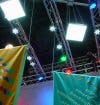Nichia
As the world's largest LED manufacturer, and the first company to commercialize white LEDs, Japan's Nichia has a strong portfolio of white LEDs targeting the lighting market. Nichia's Dan Doxsee explained to LEDs Magazine that the 0.6 W version of the company's Rigel device is available at a range of key color temperatures.
Cool white LEDs are manufactured by combining blue LED chips with yellow-emitting YAG phosphors, while warmer white colors (lower color temperatures) can be realized by increasing the proportion of a second phosphor emitting in the red region. While the efficacy of warm white devices is often much lower than cool white, Nichia's devices demonstrate only a gentle gradation in efficacy from 30 lm/W for the cool white temperatures, to 28 lm/W for a color temperature of 4100 K (equivalent to a cool white fluorescent) to 26 lm/W at 3500 K(warm white fluorescent) to 24 lm/W for 2800 K (incandescent).
These efficacy values will each be increased by 10 lm/W by the fourth quarter of 2005, says Doxsee, and at around the same time a 1.2-W version of the Rigel (Power Rigel) will be introduced, featuring a package with better thermal performance. The 0.6 W version of Rigel is supplied in a ceramic surface-mount package which is reflow-solderable and lead free.
While the warm-white version of Rigel provides a typical luminous flux of 12 - 14 lm (depending on the color rank), the higher-power one-watt Jupiter package provides 32 lm for warm white (0.450, 0.408) and 42 lm for cool white (0.31, 0.32). Jupiter is available in the Jigsaw package (LED on metal core PCB), which has a similar footprint to the standard Luxeon package from Lumileds.
White LEDs from GELcore offer range of CCT and CRI
One of the most interesting announcements of the show was a new high-power white LED from GELcore (see press release). The company, a joint venture between GE Lighting and Emcore, has concentrated on the signage market of late with its Tetra products (including a high-power white version). The new lighting product was shown in a dome-shaped package in 1- and 4-watt versions. Kraig Kasler, Vice President of Marketing at GELcore told LEDs Magazine that the 1-watt package contains one chip (1 x 1 mm) and the 4-watt contains 3 chips. The product is scalable to 8-W by adding more chips into the package. “Since the GELcore approach is a remote phosphor system (similar to CFL), it enables various lamp forms,” said Kasler.
Also, GELcore has developed numerous phosphor blends, allowing it to offer expanded color temperature options (3000K, 3500K, 4100K, 5000K or 6500K) and a wide range of color-rendering indices (70 up to 95 CRI) to meet specific end-user requirements (see New GELcore phosphors improve color-rendering index). GELcore indicated that its product has a lifetime of 20,000 hours and an efficiency of 25 lm/W for warm white.
GELcore indicates that it is targeting settings where quality of light is important - in terms of high color-rendering, low lamp-to-lamp variability and precise color temperature choice – which might include display-case lighting in retail and museum settings, wall-washing in environments such as aircraft interiors, or task lighting in medical applications.
Cree Lighting
As well as announcing a design win for its RGB XLamp LEDs with Color Kinetics (see news item), Cree Lighting was one of two companies (the other being Color Kinetics) to light their booth entirely with LEDs. Cree used more than 3500 high brightness XLamp 7090 LEDs in a series of white and colored fixtures. The luminaires generated nearly 190 kilo-lumens of light with a power consumption of approximately 6,500 watts of power, around half the value required by equivalent incandescent light. "We set out to demonstrate the general illumination capabilities of high brightness LEDs by creating dramatic exhibit lighting," said Chris James, Cree Lighting marketing manager.
Lumileds
Achieving a consistent color temperature with LEDs is a major challenge because of the wide color variations inherent in the LED manufacturing process. Manufacturers offer a wide range of products, known as bins, but obtaining color consistency even within a bin can be difficult. For the manufacturers, costs are kept high if they are not able to sell all of their production distribution.
A solution offered by Lumileds was to introduce color-matched white Luxeon Lamps, each containing multiple white Luxeon LEDs, which are selected by advanced binning algorithms. By correctly combining an appropriate mix of LEDs, the Lamps themselves have a well-controlled and consistent color temperatures of either 3200K (warm white), 4100K (commercial white) or 5500K (cool white).
"The lighting community looks for white-point consistency whether viewing the light source directly or the effect that's being created," said Keith Scott. "Our Luxeon Lamps offer the first practical solution to the problem by supplying pre-matched, pre-mounted LEDs that not only provide the desired color consistency but also speed time to market for the finished product."
Also at LightFair, Lumileds announced that its standard Luxeon 1 emitter offers a luminous flux of 45 lm, and the company also showcased its forthcoming redesigned product, designated K2 (see Lumileds upgrades Luxeon I, reveals white lamps).










